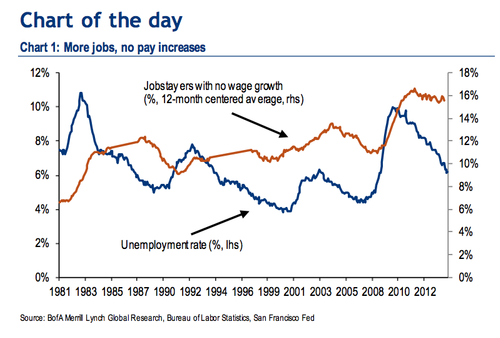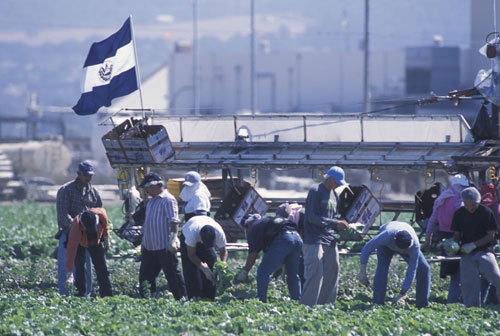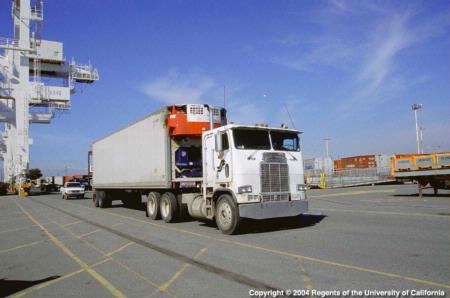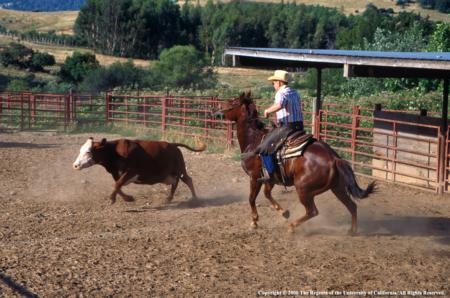
Posts Tagged: Economy
Where is the Wage Growth?
One of the surprising things about the current economic recovery is that while unemployment is falling, wage growth on a national level is almost non-existent (see chart below). Granted, in the berry business on the Central Coast, our labor issues are more complex as they involve economic improvement in Mexico as well as competition for workers from the hospitality and construction industries (and subsequently wages have been creeping up for the last couple of years), but nevertheless I think it's important enough to understand the bigger picture that we spend a moment on it.
Let's go then to a recent speech given by Federal Reserve Chairwoman Janet Yellen, which goes some ways to explain what is happening here.
The excerpt below is pretty dense, but I'll summarize it for you in three points:
1. Wages were not cut very much during the Great Recession, meaning that they well could have been unrealistically high over the past few years of economic recovery. Which means that right now wages might have finally reached an appropriate level, so employers are still not having raise wages too much to attract qualified workers.
2. Productivity in this economic up cycle has been rising faster than wages, implying that the real cost of labor has been falling - in other words saying that while the economy is strong thanks in part to gains in productivity, wages haven't necessarily needed to follow. Importantly, looking forward, these gains in productivity may continue to persist, meaning that large wage gains might not be in the offing for quite some time into the future.
3. Conversely, watch for the possibility of wage gains even though full employment hasn't yet been reached. Some workers who have been unemployed for a while might have difficulty getting back even though they are actively looking because their skill set isn't in step with what is now needed. As communicated to me by a city official, this might in fact be the case in Watsonville, which still has an unemployment rate of around 15% even though the local agricultural economy is quite strong.
For those interested in the details, here is the excerpt:
"…since wage movements have historically been sensitive to tightness in the labor market, the recent behavior of both nominal and real wages point to weaker labor market conditions than would be indicated by the current unemployment rate.
There are three reasons, however, why we should be cautious in drawing such a conclusion. First, the sluggish pace of nominal and real wage growth in recent years may reflect the phenomenon of “pent-up wage deflation.” The evidence suggests that many firms faced significant constraints in lowering compensation during the recession and the earlier part of the recovery because of “downward nominal wage rigidity”–namely, an inability or unwillingness on the part of firms to cut nominal wages. To the extent that firms faced limits in reducing real and nominal wages when the labor market was exceptionally weak, they may find that now they do not need to raise wages to attract qualified workers. As a result, wages might rise relatively slowly as the labor market strengthens. If pent-up wage deflation is holding down wage growth, the current very moderate wage growth could be a misleading signal of the degree of remaining slack. Further, wages could begin to rise at a noticeably more rapid pace once pent-up wage deflation has been absorbed.
Second, wage developments reflect not only cyclical but also secular trends that have likely affected the evolution of labor's share of income in recent years. As I noted, real wages have been rising less rapidly than productivity, implying that real unit labor costs have been declining, a pattern suggesting that there is scope for nominal wages to accelerate from their recent pace without creating meaningful inflationary pressure. However, research suggests that the decline in real unit labor costs may partly reflect secular factors that predate the recession, including changing patterns of production and international trade, as well as measurement issues. If so, productivity growth could continue to outpace real wage gains even when the economy is again operating at its potential.
A third issue that complicates the interpretation of wage trends is the possibility that, because of the dislocations of the Great Recession, transitory wage and price pressures could emerge well before maximum sustainable employment has been reached, although they would abate over time as the economy moves back toward maximum employment. The argument is that workers who have suffered long-term unemployment–along with, perhaps, those who have dropped out of the labor force but would return to work in a stronger economy–face significant impediments to reemployment. In this case, further improvement in the labor market could entail stronger wage pressures for a time before maximum employment has been attained.
H/T http://www.thereformedbroker.com/
Thanks Josh!

Chart of the day
Solve economy, wildfires woes at same time
Forest restoration would be one way to improve our economy, writes researcher Tong Wu of the Center for Forestry and UC Berkeley on CNN's Global Public Square news website. He states that human interference has "made many ecosystems unnaturally susceptible to catastrophic wildfires" and that global warming will exacerbate the problem.

"In economic analyses of environmental management projects across the western United States, ecological restoration produced multiplier effects (the economic 'bang for the buck' of every dollar spent) that were higher than the estimated impacts of the 2009 government stimulus," he wrote.
E-Verify is 'divisive,' says Monterey Herald columnist
Pending federal legislation that would require employers to check worker eligibility using an system called E-Verify is divisive and unrealistic, writes attorney Dirk Stemermen in his Monterey Herald column "On the Job."
"Nothing turns conservative 'growers' into immigrant-rights advocates quicker than obligatory E-Verify use," Stemermen said.
E-Verify, which checks information from an employee's I-9 Employment Eligibility Verification Form against government records to determine U.S. employment eligibility, is already in use in Arizona, Mississippi, Georgia and Alabama.
Stemermen said that economists at UC Davis and the USDA released a study last month concluding that such crackdowns on undocumented farmworkers raise labor costs as documented workers demand better wages and working conditions.
The columnist seems to be referring to research covered in a recent UC Davis news story that said immigration reform and stricter enforcement of current immigration laws could significantly boost labor costs for California’s $20 billion fresh fruit, nut and vegetable crops.
“California’s produce industry depends on a constant influx of new, foreign-born laborers, and more than half of those are unauthorized laborers, primarily from Mexico,” the news release quoted Phillip Martin, a professor of agricultural and resource economics and one of the nation’s leading authorities on agricultural labor.
“The cost of hiring these laborers will likely rise as the U.S. government ramps up enforcement of immigration laws by installing more physical barriers along the U.S.-Mexico border and requiring more audits of workers’ I-9 employment verification forms,” Martin says.
Stemermen also raised the issue of farmworker overtime pay in his column. California farmworkers don't receive overtime pay unless they work more than 10 hours in a day or 60 hours in a week.
"Verifying employment eligibility through E-Verify or paying California farmworkers more overtime would lead to higher farmworker wages and create jobs for documented workers. But because farmworkers are so poorly paid for the unwanted, arduous work they perform, perhaps a bit of realism needs to be injected into the immigration debate," Stemermen wrote.

Farmworkers harvest vegetables in the Salinas Valley.
Trade conflict with Mexico impending
California farmers will have to pay millions of dollars to Mexican authorities to export their products to the neighboring country if a trucking dispute is not resolved before summer, according to an article in La Opinión. Mexico plans to impose the new tariff in retaliation for the cancellation of a U.S. pilot program that permitted Mexican trucks to transport goods on U.S. highways.
The Border Trade Alliance reported this week that California agriculture will be the second most impacted economic sector if the two countries do not reach an agreement in relation to the free passage of Mexican trucks in U.S. territory, the article said.
"The retaliatory tariffs that Mexico has imposed on U.S. goods in response to the trucking impasse are hurting the U.S. economy and are a drag on President Obama's goal to double exports," BTA president Nelson Balido said in a statement released by the organization. "As Texas A&M University's Center for North American Studies recently reported, the U.S. agriculture sector alone has been negatively affected by the tariffs to the tune of $153 billion."
La Opinión reporter Claudia Nuñez spoke to the director of the UC Agricultural Issues Center, Dan Sumner, about the potential economic impact of the trade dispute.
"California exports about 20 percent if its agricultural production, principally to Mexico," he was quoted in the article.

U.S. and Mexican governments are involved in a a cross-border trucking dispute that could hurt both countries.
It's boon time for beef producers
Cattle ranchers are enjoying an economic boon, reported Reed Fujii of the Stockton Record. In March, beef cattle were being sold at an all-time high of $1.16 a pound, a jump of more than 40 percent in less than two years.
"Prices are good. They've never been this good before," the story quoted Galt rancher Duane Martin Jr.
Dan Sumner, director of the UC Agricultural Issues Center, told Fujii the primary driver of the price hike is short beef supply.
"One of the things that happened a few years ago: We had these incredibly high grain prices, and beef prices didn't go up, so that meant guys were selling," Sumner was quoted.
In addition, it takes time to beef up production.
"Cattle make cattle; the only way you make marketable animals is to have breeding stock," Sumner said.
To do so, however, will further reduce beef supplies in the short run.
A steak house owner told Fujii that so far he has not increased the prices of beef on the menu.
"I've absorbed everything for the last year or so on beef," he said.

High beef prices make for happy cowboys.
